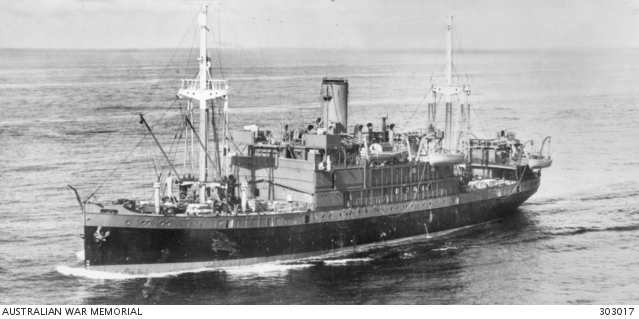Allies in adversity, Australia and the Dutch in the Pacific War: Dutch merchant shipping in the south-west Pacific
Dutch merchant shipping losses in the Pacific war
At the outbreak of the Second World War, the Netherlands had one of the largest merchant fleets in the world, and carried on a thriving trade with both its resource-rich colonies and with other nations. By the end of the war, more than 1.3 million tons of Dutch shipping had been lost at sea. Many of these vessels had fallen victim to U-boats, bombers, and commerce raiders in the Atlantic, as they attempted to keep the vital supply lines to and from Great Britain open, but many were also sunk or captured by the Japanese in the waters of the Pacific and Indian Oceans.
As the invading Japanese forces reached the major NEI ports of Padang, Tandjong Priok, Tjilatjap and Surabaya, Dutch vessels, often packed with refugees, fled before them, seeking the relative safety of Ceylon or Australia. Those incapable of sailing were scuttled to deny them to the enemy. Many of the fugitive ships were sunk or captured en route, but many eventually reached friendly ports. These vessels were destined to play a vital role in the Pacific war.
The surviving Dutch freighters, most of which belonged to the country’s major shipping line, Koninklijke Paketvaart Maatschappij (or KPM), were soon placed under the control of the US army, via the Allied Consultative Shipping Council (ACSC). They eventually numbered nearly 30, many of them converted in Australia to become “Defensively Equipped Merchant Ships”, or DEMS, as they were familiarly known, with Australian gun crews on board.
Transport vessels were at a premium, and the Dutch vessels became an essential part of offensive operations from Australia . In May 1942, the Australian 14th Infantry Brigade was taken to Port Moresby by a convoy of the KPM ships Bantam, Bontekoe, VanHeemskirk, and VanHeutz. Reinforcements for Milne Bay were carried by Bontekoe, Karsik, Swartenhondt, Tasman, Japara, VanHeemskirk, VanHeutz and s’Jacob. During 1942–43 the vast majority of all supplies reaching Allied troops in New Guinea were carried by the Dutch ships.
At a time when few of the NEI armed forces were strong enough or well enough equipped to carry the war to the enemy, it is no exaggeration to say that the greatest Dutch contribution to the final Allied victory was made by the men of its merchant fleet.
The 8,237-ton tanker Manvantara, which was sunk by Japanese aircraft on 13 February 1942 while attempting to escape from Palembang.
The 2,608–ton KPM steamer Both, which helped transport the Australian troops of “Gull Force” to Ambon in December 1941, and later took part in the Operation Lilliput supply convoys to New Guinea in 1943.
Geoffrey Mainwaring, Unloading a Dutch ship (1943, pen and ink, watercolour on paper, 40.6 x 56.3 cm) The dangers faced by merchant seamen in the Pacific war are well illustrated by this painting, made at Milne Bay in 1943. One of the Dutch KPM vessels (possibly the Van Heutz) is unloaded at Gili Gili wharf, while the Chinese steamer Anshun, which was sunk by Japanese cruisers on the night of 6–7 September 1942, lies on its side nearby.


